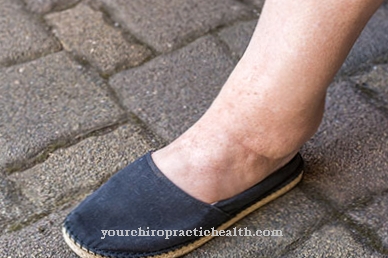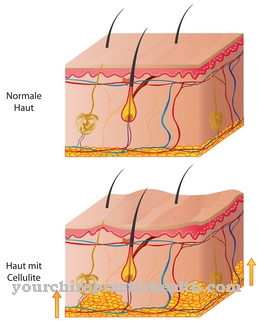As Cut This is a term used to describe a wound that is created using a sharp object such as a knife. Unlike injuries due to high temperatures or chemical wounds, the cut therefore belongs to the group of mechanical injuries.
What is a cut?

© Lukassek - stock.adobe.com
The Cut created by the action of a sharp-edged object. It is thus assigned to the mechanical injuries that are caused by sharp violence. Due to the sharp-edged shape of the acting object, the cut wound is characterized by smooth wound edges.
In addition, there is usually little gap between them. Since a cut is caused by a punctual force of the object causing the wound, the surrounding skin areas usually remain uninjured. Instead, layers of tissue under the skin may be affected.
Another characteristic of the incision is therefore profuse bleeding, which can occur particularly violently if an artery is affected. If bacteria have got into the wound, they can be flushed out by the heavy bleeding and infection of the cut wound can be prevented.
causes
The causes of a Cut are of diverse nature. A household accident is classic: one wrong movement while cutting tomatoes or a poorly executed cut with a carpet knife and your own fingers are affected instead of tomatoes or carpets.
It is also not uncommon for a shard of glass to drill its way through the thin soles of a shoe in summer and injure the foot. Finally, a thin slice of paper can accidentally cut it. Certain professional fields can also be predestined for a cut.
For example, people in the medical profession have more frequent use of pointed and sharp-edged objects such as scalpels and syringes, which can easily cut.
Symptoms, ailments & signs
A cut is accompanied by fairly typical and clear symptoms, so that affected people can often diagnose a cut themselves. In most cases, there is profuse bleeding, which may even need medical attention and medication. Another sign of a cut is a strong burning sensation in the area.
Of course, cuts can occur in different degrees of severity, so that the severity of the bleeding also depends on this. If the person concerned does not seek medical care, then under certain circumstances a large amount of blood can be lost. Therefore, a visit to the doctor should not be put off the long bench.
Another symptom of a cut is prolonged numbness if muscles or tendons have been injured. If this symptom occurs, a doctor must be consulted immediately. Otherwise, permanent consequential damage can occur if a visit to the doctor is omitted.
If only the uppermost layers of skin are injured by the cut, only minor bleeding can be expected. In such a case there are no further symptoms or complaints. Cuts are accompanied by fairly clear symptoms that can vary depending on the severity.
Diagnosis & course
Factors in determining the type and severity of a Cut are the cause of the wound and the affected tissue. With regard to the type of wound, the cut is determined by the injuring object. This is usually sharp-edged, which manifests itself in smooth wound edges.
The severity of the wound depends, among other things, on whether it is an internal or external injury. For example, a cut that has only scratched the outer skin is less of a concern than a cut that affects the internal organs.
The complexity of the wound is also critical. In the case of a complicated cut, tendons, joints or nerves are also affected in addition to the skin. The more complicated it is, the more complex the treatment of the cut is.
Complications
Smaller cuts, such as those that often occur on the fingers and hands, usually heal without complications in healthy people after a few days. At most, a small scar remains, but it fades over time.
However, complications can arise under certain conditions. Serious cuts that perforate larger blood vessels can lead to severe blood loss and, as a result, to circulatory shock. Rapid hemostasis is then required, otherwise the person concerned is at risk of death.
Complications are also to be expected if the cut has not only injured the skin, but also nerves or tendons. In severe cases it is possible that after nerve injuries in the hands, as is sometimes the case in kitchen accidents, one or more fingers are no longer fully able to move or feel numb. After a tendon injury, the fingers may not be able to flex and stretch.
In addition, complications can be expected if the wound was injured with a contaminated object and was not then thoroughly cleaned and disinfected. In mild cases, only the tissue near the wound becomes infected, but in a more severe course, sepsis (blood poisoning) can develop.
When should you go to the doctor?
If the cut is only superficial, it is usually sufficient to treat it with a plaster, other dressing material and wound gel. After a short time, the bleeding should be stopped and the wound healing will begin.
A visit to the doctor is only necessary if the wound has gaping edges and is also very deep. If the bleeding cannot be stopped, a practice should be visited immediately so that the wound can be treated there. Infections can also be dangerous; the cut can be so small. Bacteria multiply within a very short time. The doctor must also examine whether nerves or tendons have been hit. He has the option to sew, staple or glue the wound. The tetanus vaccination may also need to be refreshed. Foreign bodies must not be removed yourself under any circumstances.
Patients who suffer from delayed blood clotting (e.g. haemophilia) must see a doctor if they have a cut. Otherwise there is a risk of severe blood loss, even with small cuts.
Treatment & Therapy
Because usually heavy bleeding with a Cut goes hand in hand, this should first be stopped to prevent greater blood loss. Ideally, a sterile compress should be used to stop the bleeding. This is pressed onto the cut wound for a few minutes until the blood flow is noticeably reduced.
Then we bandage the wound or another wound dressing. If the cut is larger or not only the upper layer of the skin is affected, a doctor should be consulted. The same applies if the cut was caused by a contaminated object and the last tetanus vaccination was a while ago.
In this case, the doctor can treat the wound with antibacterial agents and thus prevent tetanus. If the wound does not stop bleeding after a long period of time, a doctor should also be consulted. In this case, adhesive plasters or a suture are used.
Facial injuries should also be treated by a doctor because, on the one hand, they usually bleed more heavily and, on the other hand, require special aesthetic expertise in the care of the cut.
prevention
A Cut can be avoided on the one hand by taking special care when handling sharp and pointed objects. The professional handling of these objects in particular often requires certain training courses that reduce the risk of injury. Special protective clothing and gloves can also prevent cuts at work. On the other hand, children should be made familiar with sharp-edged objects in accordance with their age in order to reduce the risk of cuts.
Aftercare
Thorough follow-up care is important if you have a cut. Because with every injury, pathogens can get into the body. Therefore, it is necessary to closely observe the wound. Redness, swelling, pain, restricted mobility, suppuration or excessive warmth can indicate inflammation of the cut.
In this case, consultation with a doctor is elementary. If the reddening spreads strongly around the wound, the lymph vessels may be inflamed. There is a risk of blood poisoning. Immediate medical care is urgently needed.If the wound has been sutured and the sutures have already been removed, the wound should still be covered with a plaster for a few days.
If the healing process is positive, bacteria can no longer get into the wound. If the cut is already covered by an intact layer of skin, the healing process is not over yet. Temporary structures are transformed into mature tissue and the skin begins to regenerate. To support this process, ointments are recommended.
Creams with dexpanthenol, vitamin A, plant extracts such as calendula, chamomile and witch hazel contribute to tissue regeneration and the formation of new cells. They give the skin suppleness and prevent scars. Appropriate ointments are available in pharmacies or drugstores. Sometimes a special scar ointment can be helpful.
You can do that yourself
Caring for a cut depends on how deep the injury is. In the case of minor cuts, it is sufficient to cover the wound area with a plaster or a small bandage. To avoid infection, these should be changed occasionally. If the cut does become inflamed, antibiotic ointments can quickly provide relief.
Deeper cuts should be treated by a doctor so that they can heal without complications. The doctor decides whether the wound needs to be stapled, glued or sewn. He can also numb the area to be treated with a local anesthetic if necessary. To prevent open or secondary wound healing, the incision must be treated within six hours. If the wound is treated later, the healing process can take much longer and leave clear scars. The best prerequisite for wound healing without complications is immediate wound care.
Cut wounds in the joint area are more stressed and can tear. To prevent this from happening, the affected joint should be immobilized with a splint. The wound edges can thus grow together better. Full baths and water sports are to be avoided until the clips or threads are removed. To do this, the wound should be closed and, if possible, without a crust.




.jpg)
.jpg)
.jpg)





















